THE “W” WORD
Onward!
I don’t want to sound like a scolding parent, but have you been paying attention to your garden? Late summer weather may not inspire any more gardening activity than reaching — among the weeds, perhaps? — for a juicy tomato. But onward: There is work to be done!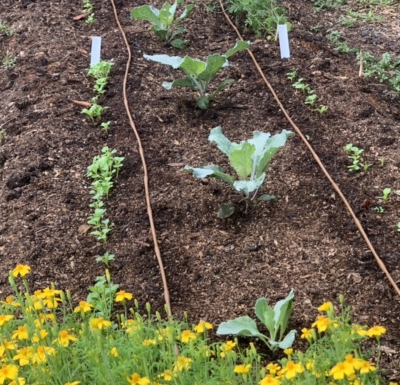
About those weeds. Wait! Don’t close your eyes and stop reading (like a reprimanded child) just because I mentioned weeds. Please hear me out.
Weeds, left now to their own devices, are going to become worse troublemakers later. Annual weeds like lamb’s-quarters and purslane are dropping their seeds, sowing them for next spring. You presumably killed all perennial weeds with this season’s enthusiastic beginnings, but the roots of young perennial weeds are trying to find a home. Autumn’s cool, moist weather is just what horse nettle, bindweed, yellow and creeping woodsorrel, and other perennial weeds need to become firmly entrenched in your garden.
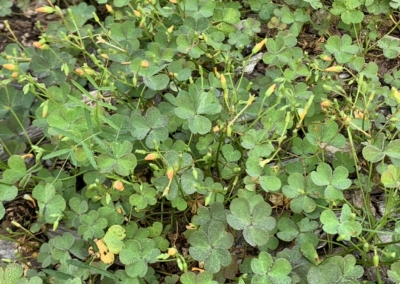
Yellow woodsorrel
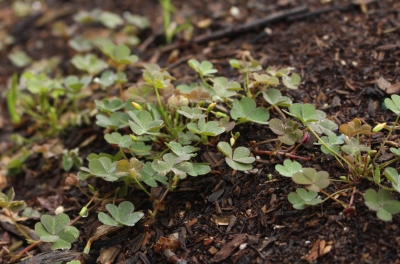
Creeping woodsorrel
Killing weeds now not only will dramatically diminish the amount of weeding you have to do next spring, but will also allow you to better appreciate your garden over the next couple of months. Do a good job of weeding and you might even bare some soil in which to sow seeds. Many perennial flowers — delphinium, clematis, and evening primrose, for example — do well sown in autumn. And seeds of annuals such as alyssum, snapdragon, poppy, and pansy can lie in the ground through winter, ready to come to life with the first breath of spring.
In the vegetable garden, there’s still time to sow lettuce, mustard, arugula, and turnip for an autumn harvest. Sow spinach seeds now for harvest in autumn and, depending on winter’s bite, even early next spring.
Autumn is a great time in the vegetable garden, the cool weather bringing out the best flavors in cabbages, Brussels sprouts, lettuces, mustard greens, and turnips. Flowers such as stonecrop sedum, delphinium, viola, and, of course, chrysanthemum will burst into bloom in the next few weeks. Even annuals like calendula, snapdragon, alyssum, and petunia will continue their show until the mercury plummets well below freezing.
The Dark Side of Weeds
You’re not going to catch sight of any blossoms on plants lost amidst a sea of weeds. Weeds also weaken garden plants, diminishing the show of flowers and the yields of vegetables. Garden plants will be stunted as weeds rob the soil of both nutrients and water. Pokeweed, lamb’s-quarters, and other taller weeds will do all that, and grab sunlight before it ever reaches shorter, cultivated flowers and vegetables.
If all that doesn’t convince you do something about weeds this time of year, some weeds — galinsoga, for example — even exude natural chemicals that act just like herbicides. Studies have shown that galinsoga suppressed germination and growth of lettuce and tomato. Creeping woodsorrel, one of the worst weeds in my gardens, also have this effect, generally known as allelopathy.
Modus Operandi
Weeding need not be a daunting task. Start at one end of the garden, then slowly and methodically make your way across to the other side. Keep an eye on what you’re doing, not what you still have left to do. Work in the cool of early morning or evening, a pleasant hour to be in the garden even if you are weeding.
Choose a method for killing weeds befitting your personality and the character of the weeds. For instance, depending on the weeds’ size and growth habit you can kill weeds with a hoe or a rototiller, or you can just bend down and rip them out with your bare hands, roots and all. 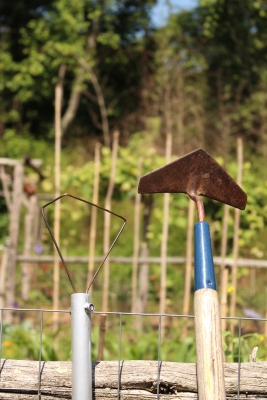
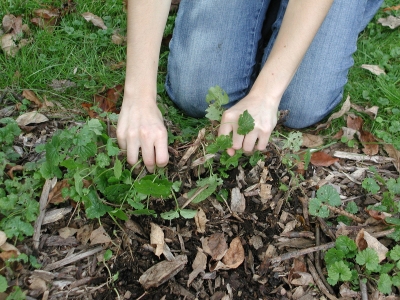
Pulling creeping charlie
Less overtly aggressive is to smother weeds beneath mulch. Four layers of wetted newspaper, topped with wood chips or straw to hide the paper from view and hold it down, is a very effective weed killer.
Tarping is a relatively new method of weed control, useful only for parts of the garden that can remain bare for two weeks or more. It’s simple: Just cover the ground with an opaque, black material. Better materials than black plastic, which is short-lived and then must be land-filled, are available. A few years ago I purchased a couple of used billboard tarps, which, in a previous incarnation, were hung as billboards. Their reverse sides are black, which is the side to face up when laid on the ground, and I just fold them up for another (and another and another and . . . ) season’s use when I finish with them. Weeds sprout in the dark environment, then die from lack of light.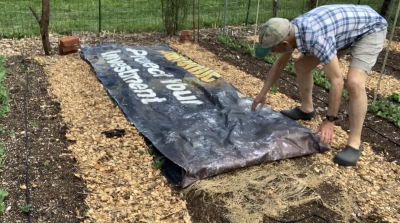
Yet another option in the weed control quiver is herbicides, weedkillers. Gasp! Again, don’t hang up . . . I mean stop reading. I’m talking about “OMRI Listed” herbicides, that is, those approved in “organic” growing. They have their place, snuffing out grasses and other weeds that thrive in the spaces between bricks of my terrace or patio. 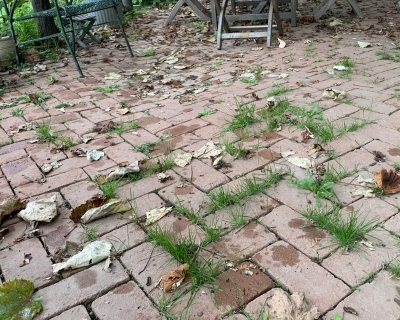 Or in garden paths overrun with previously mentioned creeping woodsorrel.
Or in garden paths overrun with previously mentioned creeping woodsorrel.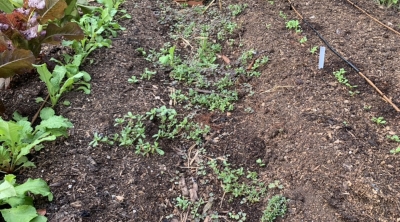
Years ago, I came up with my own organic herbicide made up of household strength vinegar with some canola oil and dish detergent. It worked well enough, but since then a number of OMRI Listed herbicides have come on the market, whose active ingredients might be: Acetic Acid, Citric Acid, d-limonene (Citrus Oil), Clove Oil or Clove Leaf Oil, Cinnamon Oil, Lemon grass Oil, Eugenol, 2-Phenethyl Propionate, Sodium Lauryl Sulfate, Ammonium Nonanoate, or Pelargonic Acid+Fatty Acids. Scary names, some of them. But you wouldn’t want to eat something containing turanose as well as butanoic and pyroglutamic acids until you found out that these are just some natural ingredients of honey.
I’ve tried a few of the OMRI Listed herbicides. My favorite thus far has been those containing ammonium nonanoate. Be aware that this herbicide as well as the others mentioned, are contact herbicides, which kill only green parts of plants. Roots store energy and will fuel growth of new leaves, so repeated applications are needed to suppress or kill weeds.
At the very least where weeds are out of control, set your lawnmower blade as low as possible, then weaken perennial weeds and prevent seeding on many annual weeds by mowing down those growing in the paths or rows between your garden plants.
For more about weeds — much more — check out my book WEEDLESS GARDENING.


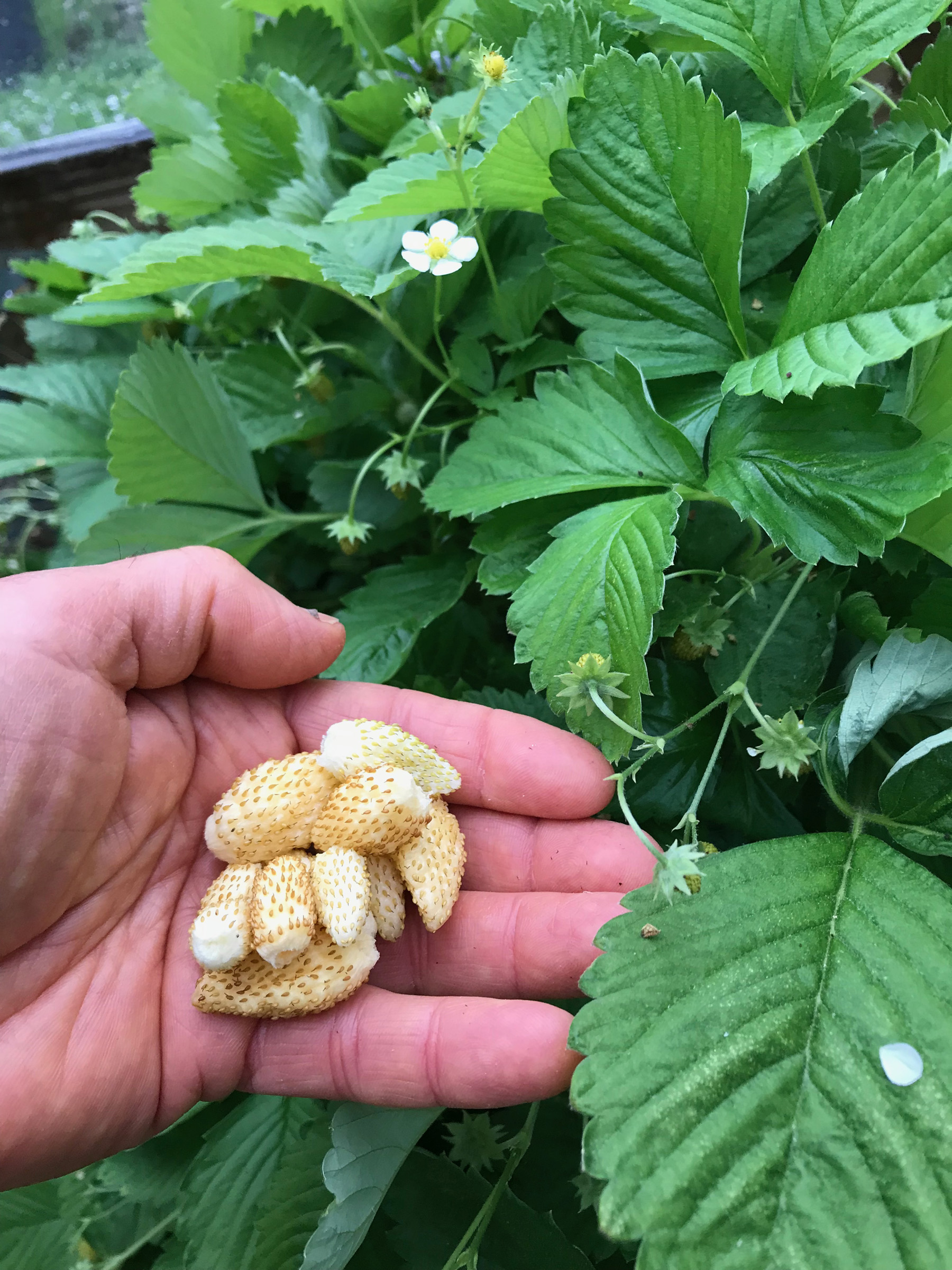

Don’t know how you find new topics to write about but…
I feel a need to defend purslane & yellow wood sorrel. I let them stay in my garden, picking them for my salads from time to time – delicious! Purslane is a ground cover for me, only pulling it from around other plants I’m growing.
I wish I liked to eat purslane, but I don’t.
try sautéing it with lettuce, scallions and fresh peas. delicious! plus purslane is highest plant source of omega 3 fatty acids
Hi Dan, Thanks for the recipe. But how do you have fresh peas at the same time as okra?
I really like flame weeding the patio and gravel path to the workshop. It makes weeding fun!